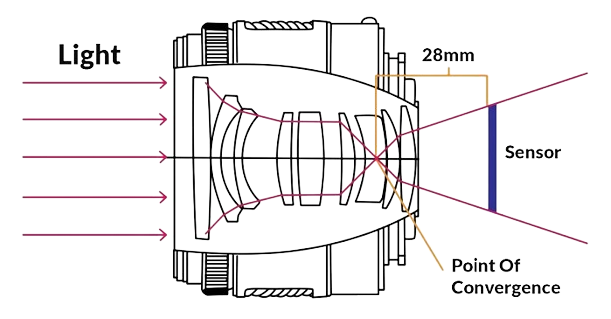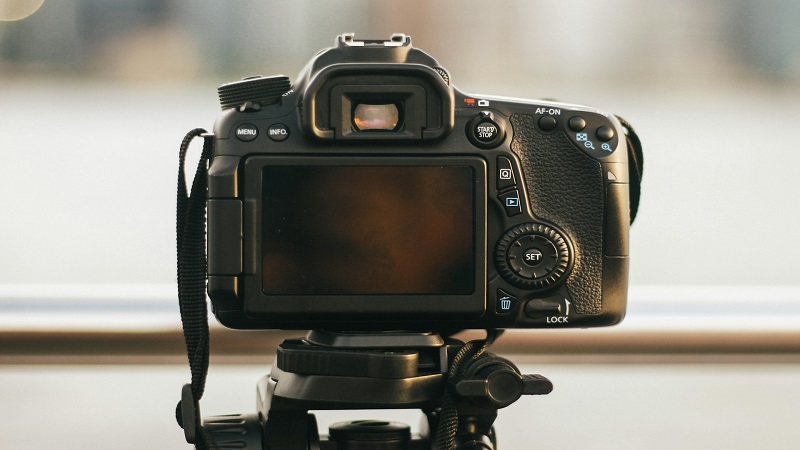Your camera is your best friend when it comes to capturing and pausing precious moments you spend with your family and friends. Do you know people upload a staggering 1.8 billion images on the internet every single day? But – have you ever wondered how does a camera capture an image? How can it freezes time allowing you to treasure those moments for the rest of your life?
How Does a Camera Capture an Image? Basic Working
The working of a camera is very similar to the human eye. You cannot see anything when you are in a dark room with no lights, windows, or doors. You will only be able to see everything inside the room if light from a certain source such as a flashlight travels in a straight light, hits an object, and bounces back into your eyes. Cameras, both film and digital cameras, work on the same principle.
All lights travel in a straight line despite their sources. However, they only allow us to see and photograph what is going on in our surroundings when they bounce off objects. It continues to travel in a straight light after hitting an object but it reflects at the same angle it comes in. It simply means light rays are moving and bouncing back in every direction. Cameras use the bouncing light to project an image on a surface.
How did the First Cameras work?
The first cameras were essentially boxes or rooms with a hole in one wall. They would develop an upside down image on the opposite wall thanks to the light entering from the hole and bouncing in a straight line.
Devices like those mentioned above existed long before the invention of the first true camera. The photography that we know of today was born when someone placed light sensitive materials at the back of that box. The material etches the images on the surface when it chemically reacts with the coming light. Photography material has been changing throughout history including everything from paper to glass.
How Do Cameras Capture Images? The Lens
The first camera was particularly slow. It took eight hours to take a single image because it could capture very little light. The images were very blurry as well. So, how modern cameras can take multiple and extremely sharp photographs in a second? They accomplish both tasks courtesy of camera lenses.
The light can refract or pass through the objects and change direction just like it can reflect or bounce off them at the same angle. The lens collects or captures all the lights bouncing around and conveys them to a single point.
The light rays create a sharp image when they converge at that point that is a camera sensor or a film in the case of digital and film cameras respectively. The image will be out-of-focus or blurry if it fails to meet at the targeted point. You can resolve this problem through a good focusing system that moves the lens away or closer to the sensor. As a result, you can take sharp and detailed images.
How much and how good a lens can zoom also depends on its distance from the camera sensor. You can zoom in when the lens or glass gets closer to the sensor. Another important thing to keep in mind is the focal length. It is the distance light covers to reach the camera sensor after it first hits the lens. For example, a 35mm lens takes roughly 35mm to redirect light to a sharp point on the camera sensor. A 35mm lens is considered a wide-angle lens that helps you capture a wide field of view. A 200 mm lens, on the other hand, is a telephoto lens and brings the action closer to you.
The Working of Digital and Film Cameras
It is the era of digital cameras. They have made it extremely simple to take countless sharp images in a quick time. However, film cameras once ruled the world of photography and some people still prefer them over digital cameras. Therefore, we are going to explain how both these types of cameras work.
Image Formation on Film or Analog Cameras
The analog cameras use a strip of film to produce the photo. The image is created when the film chemically reacts with the light coming from the lens. Most analog cameras use a 35mm film coated with a chemical substance known as a silver halide.
It is actually silver halide that reacts with the light and creates an image negative that we were so familiar with just a few years ago.
The following equation will make it even simpler to understand.
Light Particles + Silver Halide = Image Negative
This is the most basic explanation of how you can capture images in a camera. Photographing an object involves many advanced concepts such as aperture width, shutter speed, focusing, image stabilization, etc. However, will stick to the basics for the sake of this article.
How Does a Digital Camera Work?
Digital cameras such as DSLRs and mirrorless cameras do not use any film to form an image. They have a more complex process of creating an image involving an array of sensors.
While they use almost the same terms, techniques, and even lenses yet they are very different from film cameras. Rather than silver halide, Digital SLRs use photosensors commonly referred to as sensors only. They are also sensitive to light just like the film. However, they use photosites instead of silver halide.
Photosites are millions of tiny holes, each of which gathers light whenever you expose them to light. They analyze the light or data they have collected after the shutter is closed.
Subsequently, they send electronic signals equal in size to the amount of light they have taken into the camera. Ultimately, all the signals converge on a single point to create a sharp image.
It seems pretty simple but there is much more to it than meets the eye. At this point, photosites cannot distinguish between different colors. Light is light for a camera sensor and it will only produce a black and white image if you don’t provide it with any more information.
Also, keep in mind that photosites are different from pixels. Photosites are smaller units and every pixel consists of or draws information from five photosites.
So, How Does a Digital Camera Create Color Images?
The responsibility to distinguish colors in digital cameras rests on something called a Bayer Filter. Perching on top of the camera sensors, it is a light filter that allows only a single color to each photosite.
The design of a Bayer filter is pretty straightforward. It is a square grid of photosites to arrange a color filter array for your camera. It has a sort of three quarters, each for red, blue, and green (RGB) colors. Red light cannot enter the quarters specified for blue and green and the same is the case for other colors.
Each photosite collects only one of the red, green, or blue colors. It helps the camera to calculate the level of intensity of each color once the light hits the photosites.
So, how does a camera produce more colors if the Bayer filter only lets red, blue, and green colors into photosites? The camera does not analyze all photosites individually. It simultaneously looks at thousands of them, especially 2 x 2 squares or a single pixel, comparing the relative strength of red, blue, and green. After doing some calculations, it produces the true color of the image.
How Does a Camera Work Diagram?
The following is a simple diagram to explain the working of a digital camera.

You Must See Beyond Pixels
Most people commit the cardinal sin of considering only pixels while purchasing a new camera. People became obsessed with megapixels when point-and-shoot cameras first became popular. As the resolution of the image greatly depends on megapixels, camera manufacturers went out of their way to cash in the frenzy. After all, the more the megapixels, more the light the sensor will collect and produce a sharper image.
However, a high-quality image also depends on the size of the pixel. A sensor with a larger number of megapixels also means smaller photosites to accommodate all those pixels. Smaller photosites are unable to capture adequate light to produce a quality image.
For example, Canon EOS Rebel T3 and iPhone 13 Pro Max have almost similar megapixels. However, the quality of the images they produce is vastly different. Rebel T3 is a dedicated camera with a much bigger sensor size than the iPhone 13 Pro Max. Therefore, the iPhone 13 Pro Max has to have smaller photosites to fit in all the pixels. It also means the iPhone’s sensor captures considerably less light than the camera.
In fact, any real camera will take better photos than any iPhone version because it has better lenses, a larger sensor, and better ergonomics.
The camera can make the best of its megapixel count only if it has a large sensor to capture more light. Therefore, you must look out for cameras with high megapixels as well as large sensors along with other features.
Also Read: How Camera Lenses Work And Camera Lenses Basics Explained
Frequently Asked Questions
How does camera film capture an image?
Camera film captures an image through a chemical process. When the camera’s shutter opens, light passes through the lens and strikes the film, which is coated with light-sensitive chemicals. These chemicals react to the light, creating a latent image that is made visible through the development process.
What catches the image in a camera?
The image in a camera is captured by either a film or a digital sensor, depending on the type of camera. In film cameras, the light-sensitive film records the image; in digital cameras, the sensor, composed of millions of tiny light-sensitive pixels, captures the light to create an image.
What is the process of capturing an image?
The process of capturing an image involves opening the camera’s shutter to let light through the lens, which then focuses the light onto a medium—either film or a digital sensor. This medium records the light patterns, capturing the image as seen through the lens at that moment.
How does a camera capture a moment?
A camera captures a moment by briefly allowing light to enter through the lens when the shutter opens. This light imprints an image onto the film or digital sensor inside the camera. The duration the shutter remains open (shutter speed) determines how much light is captured, affecting the image’s brightness and clarity.
What are the physics behind cameras?
The physics behind cameras involves optics and light sensitivity. Cameras use lenses to focus light rays onto a specific point, creating a sharp image. The aperture controls the amount of light entering, and the shutter speed determines the exposure time. On a digital camera, the sensor converts the light into electrical signals to produce an image.
Final Thought
We hope you have a better understanding of the working of a camera after reading our article about how does a camera capture an image. We have tried to explain everything simply and concisely. Also, remember that we have only covered the basics here. We will talk about more advanced concepts in our other guides which are coming soon as well.

